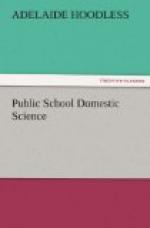EGGS.
Eggs contain all the ingredients necessary to support life. Out of an egg the entire structure of the bird—bones, nerves, muscles, viscera, and feathers—is developed. The inner portion of the shell is dissolved to furnish phosphate for the bones. The composition of a hen’s egg is about as follows (Church):—
----------------------+------------++------------------
---+------------ | White--In || | Yolk--In | 100 parts. || | 100 parts. ----------------------+------------++---------------------+-
----------- Water | 84.8 || Water | 51.5 Albumen | 12.0 || Casein and albumen | 15.0 Fat, sugar, | || Oil and fat | 30.0 extractives, etc. | 2.0 || Pigment | Mineral matter | 1.2 || extractives, etc. | 2.1 | || Mineral matter | 1.4 ----------------------+------------++---------------------+-
-----------
The albumen—or the “white”—of an egg is greatly altered by cooking. When heated beyond boiling point it becomes a very indigestible substance. Eggs cooked at a temperature of about 170 deg. F., leaving the whites soft, are easily digested. A raw egg is ordinarily digested in 1-1/2 hour, while a baked egg requires from 2 to 3 hours. Eggs baked in puddings, or in any other manner, form one of the most insoluble varieties of albumen.
GELATIN.
Gelatin is obtained from bones, ligaments, and other connective tissues. In combinations with other foods it has considerable nutritive value. The place given to it by scientists is to save the albumen of the body; as it does not help to form tissue or repair waste it cannot replace albumen entirely. Gelatin will not sustain life, but when used in the form of soup stock, etc., is considered valuable as a stimulant.
* * * * *
LEGUMES—PEAS, BEANS AND LENTILS.
These vegetables contain as much protein as meat; yet, this being inferior in quality to that contained in meat, they can scarcely be given a place in the same class; therefore we will give them an intermediate position in food value between meat and grains. From the standpoint of economy they occupy a high place in nutritive value, especially for outdoor workers. (See Recipes.)
CHAPTER VI.
Fats and Oils.
Fats and oils contain three elements—carbon, oxygen and hydrogen. About one-fifth of the body is composed of fat. Before death results from starvation 90 per cent. of the body fat is consumed.
USES OF FAT.
(1) To furnish energy for the development of heat; (2) to supply force; (3) to serve as covering and protection in the body; (4) to lubricate the various structures of the body; and (5) to spare the tissues. The fats and oils used as food all serve the same purpose, and come before the carbohydrates in fuel and force value; in combination with proteids, they form valuable foods for those engaged in severe muscular exercise, such as army marching, mining expeditions, etc.




